| Luku 8. Kuvien yhdistäminen | ||
|---|---|---|

|
Osa II. Kuinka tulla GIMP velhoksi? |  |
Sisällys
You can think of layers as a stack of slides. Using layers, you can construct an image of several conceptual parts, each of which can be manipulated without affecting any other part of the image. Layers are stacked on top of each other. The bottom layer is the background of the image, and the components in the foreground of the image come above it.
There is no limit to the number of layers an image can have, only the amount of memory available on the system. It is not uncommon for advanced users to work with images containing dozens of layers. You can group layers to make your work easier, and there are many commands to handle layers.
The organization of layers in an image is shown in the Layers dialog, which is the second most important type of dialog window in GIMP, after the Main Toolbox. How it works is described in detail in the Layers Dialog section, but we will touch some aspects of it here, in relation to the layer properties that they display.
Each open image has at any time a single active drawable. A ”drawable” is a GIMP concept that includes layers, but also several other items, such as channels, layer masks, and the selection mask. Basically, a ”drawable” is anything that can be drawn on with painting tools. If a layer is currently active, it is shown highlighted in the Layers dialog, and its name is shown in the status area of the image window. If not, you can activate it by clicking on it. If none of the layers are highlighted, it means the active drawable is something else than a layer.
In the menu bar, you can find a menu called , containing a number of commands that affect the active layer of the image. The same menu can be accessed by right-clicking in the Layers dialog.
Jokaisella tasolla on monia tärkeitä ominaisuuksia:
Every layer has a name. This is assigned automatically when the layer is created, but you can change it. You can change the name of a layer either by double-clicking on it in the Layers dialog, or by right-clicking there, and then selecting the top entry in the menu that appears, .
An alpha channel encodes information about how transparent a layer is at each pixel. It is visible in the Channel Dialog: white is complete opacity, black is complete transparency and gray levels are partial transparencies.
The background layer is special. If you have just created a new image, it only has one layer, which is the background layer. If the image has been created with an opaque Fill type, this one layer has no Alpha channel. To get a background layer with transparency, either create your new image with a transparent Fill type, or you use the Add an Alpha Channel command.
If you add a new layer, even with an opaque Fill type, an Alpha channel is automatically added to the layer.
Every layer other than the bottom layer of an image automatically has an Alpha channel, but you can't see a grayscale representation of the alpha values. See Alpha in Glossary for more information.
Kuva 8.2. Alpha kanava esimerkki: Tavallinen kuva
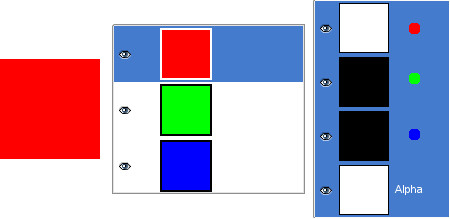
This image has three layers painted with pure 100% opaque Red, Green, and Blue. In the Channel Dialog, you can see that an alpha Channel has been added. It is white because the image is not transparent since there is at least one 100% opaque layer. The current layer is the red one: since it is painted with pure red, there is no green and no blue and the corresponding channels are black.
Kuva 8.3. Alpha kanava esimerkki: Yksi läpinäkyvä taso
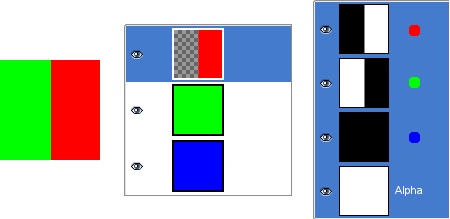
Vasen osa ensimmäistä kerrosta on tehty läpinäkyväksi (Suorakulmainen valinta, Muokkaa/Tyhjennä). Toinen kerros, vihreä, on näkyvissä. Alpha kanava on silti valkoinen, koska tässä kohdassa kuvaa on vielä läpinäkymätön taso.
Kuva 8.4. Alpha kanava esimerkki: Kaksi läpinäkyvää tasoa
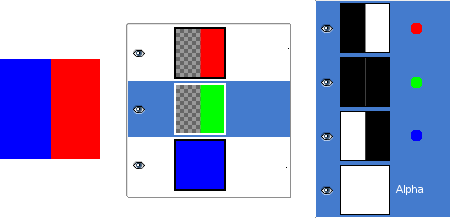
Vasen osa toista kerrosta on tehty läpinäkyväksi. Kolmas taso, sininen, on näkyvissä ensimmäisen ja toinen kerroksen läpi. Alpha kanava on silti valkoinen, koska tässä kohdassa kuvaa on vielä läpinäkymätön taso.
Kuva 8.5. Alpha kanava esimerkki: Kolme läpinäkyvää tasoa
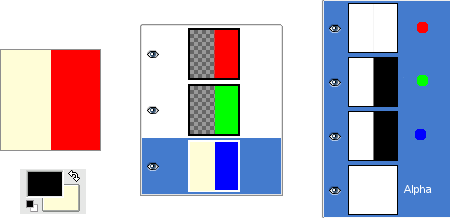
The left part of the third layer has been cleared. The Alpha channel is still white and the left part of the layer is opaque, because the background layer has no Alpha channel. In this case, the Clear command works like the Eraser and uses the Background color of Toolbox.
Kuva 8.6. Alpha kanava esimerkki: Taustaan lisätty Alpha kanava
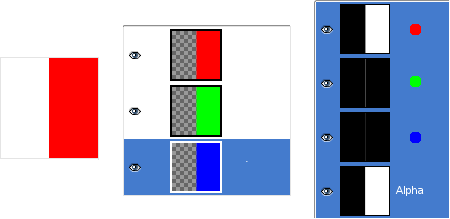
We used the → → command, on the Background layer. Now, the left part of the image is fully transparent and has the color of the page where the image is shown. The left part of the Alpha Channel thumbnail is black (transparent) in the Channel Dialog.
The layer type is determined by the image type (see previous section), and the presence or absence of an alpha channel. These are the possible layer types:
RGB
RGBA
Harmaa
HarmaaA
Indeksoitu
IndeksoituA
The main reason this matters is that some filters (in the menu) only accept a subset of layer types, and appear disabled in the menu if the active layer does not have a supported type. Often you can rectify this either by changing the mode of the image, or by adding or removing an alpha channel.
 Näkyvyys
Näkyvyys
Kuvasta on mahdollista poistaa taso tuhoamatta sittä napsauttamalla symbolia Tasot dialogista. Tätä kutsutaan tason ”näkyvyyden vaihtamiseksi”. Useimmat kuvan toiminnot käsittelevät pois päältä olevia tasoja, niin kuin niitä ei olisi olemassa. Kun työskentelet kuvien kanssa, joissa on useita tasoja, joissa on vaihtelevasti läpinäkymättömyyttä, saat usein paremmin selvää sen tason sisällöstä, jota haluat työstää piilottamalla osan muista tasoista.
![[Vihje]](images/tip.png)
|
Vihje |
|---|---|
|
Jos Shift-napsautat silmä symbolia saat piilotettua kaikki tasot paitsi sen, jota napsautit katoamaan. |
Usually, you activate a layer, to work on it, clicking it in the layer list. When you have a lot of layers, finding which layer an element of the image belongs to is not easy: then, press Alt and click with Mouse wheel on this element to activate its layer. The available layers will be looped through (starting from the upper one) while the Alt is held and the picked layer will be temporarily displayed in the status bar.
 Linkitys muihin tasoihin
Linkitys muihin tasoihin
Jos napsautat silmä ikonin ja tason esikatselukuvan väliin, saat ketju ikonin, joka mahdollistaa tasojen ryhmittelyn useaa tasoa muokkaavaan toimintaan (esimerkiksi Siirrä työkalulla tai muunnos työkalulla).
In GIMP, the boundaries of a layer do not necessarily match the boundaries of the image that contains it. When you create text, for example, each text item belongs to its own separate layer, and the layer size is automatically adjusted to contain the text and nothing more. Also, when you create a new layer using cut-and-paste, the new layer is sized just large enough to contain the pasted item. In the image window, the boundaries of the currently active layer are shown outlined with a black-and-yellow dashed line.
Pääasiallinen syy miksi tällä on merkitystä on se, että et voi tehdä tasolle mitään sen rajojen ulkopuolella: et voi tehdä asioille mitään, jos ne eivät ole olemassa. Jos tästä koituu ongelmia, voit muuttaa tason kokoa käyttämällä, jotain useasta komennosta, jotka löytyvät melkein valikon pohjalta.
![[Huomaa]](images/note.png)
|
Huomaa |
|---|---|
|
Tason käyttämän muistin määrä määräytyy sen ulottuvuuksien mukaan, eikä sen sisällön mukaan. Joten, jos työskentelet suurempien kuvien tai useita tasoja sisältävien kuvien kanssa, saattaa olla parasta säätää tason pienimpään mahdolliseen kokoon. |
Tason peittävyys määrittää missä määrin se päästää alempien tasojen pinoista värejä läpi. Peittävyys käyttää arvoja välillä 0-100, jossa 0 tarkoittaa täyttä läpinäkyvyyttä ja 100 tarkoitta täyttä läpinäkymättömyyttä.
Tason tila määrittää miten tason värit yhdistetään alempien tasojen värien kanssa tuottamaan näkyvä tulos. Tämä riittävän monimutkaista ja riittävän tärkeä käsite, jotta se tarvitsee oman kappaleensa, joka on seuraava. Katso Kohta 2, ”Tason tilat”.
Alpha kanavan lisäksi on olemassa toinen tapa hallita tason läpinäkyvyyttä: lisäämällä tasomaskin, joka on ylimääräinen tasoon liittyvä piirrettävä harmaasävy. Tasolla ei ole oletuksena tasomaskia: se tulee lisätä erikseen. Tasomaskit ja miten niillä työskennellään on kuvattu paljon tarkemmin Tasomaski osiossa.